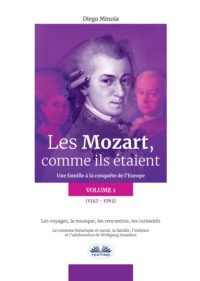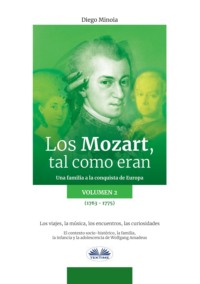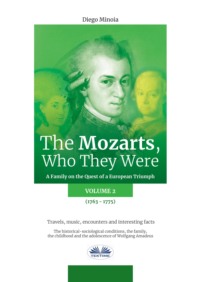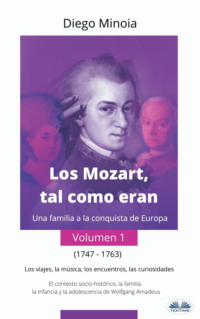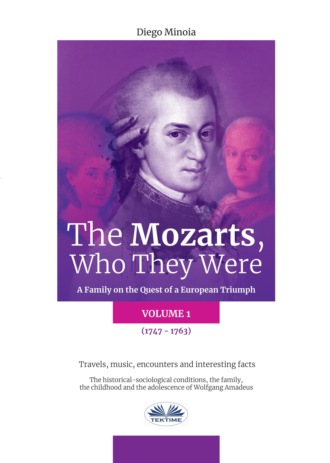
Полная версия
The Mozarts, Who They Were (Volume 1)

The Mozarts, Who They Were
TRANSLATED BY DENA MARZULLO
Diego Minoia
The Mozarts, Who They Were
A Family on the Quest of a European Triumph
Travels, music, encounters and interesting facts
The historical-sociological conditions, the family,
the childhood and the adolescence of Wolfgang Amadeus
Volume I
(1747 - 1763)
www.diegominoa.it
All rights reserved
No part of this book may be reproduced without the written consent of the author
Copyright © Diego Minoia 2020
www.diegominoia.it
info@diegominoia.it
Cover design: Marta Colosio
Diego Minoia
The Mozarts, Who They Were
A Family on the Quest of a European Triumph
Travels, music, encounters and interesting facts
Table of Contents
Volume I
Part 1: Salzburg and the Mozart family
Salzburg - The Prince-Bishops -- Interesting facts on Salzburg -- Music at the Court of the Prince-Bishopric -- The musicians of the Salzburg Court -- The Mozart family (mother, sister, father, Wolfgang) -- Wolfgang's station in the history of music -- The life of the Mozart family in Salzburg -- Mozart's earnings -- The catalogue of the Mozartian compositions
Part 2: School of thought, culture and society in the 1700s
The geopolitical situation during the 18th century -- The Age of Enlightenment -- Society during the Mozart epoch -- Theater, influence and society -- Theater and the impresario -- The dedications and the earnings of composers and librettists -- The castrated -- Protected, borrowed and stolen musicians -- Music of the 1700s -- The role of the musician during the second half of the 1700s -- The Melodramma -- Music and the church -- The principle forms of church music - The evolution and perfection of musical instruments during the 1700s -- Pre-Romantic Mozart?
Part 3: Daily life during Mozart's time
The household in Europe in the 1700s -- Pannier or farthingale -- Laundry -- Ice -- Food and the evolution of taste -- Artists and their role in society - Various habits and interesting facts: household pets, high fashion à la Française -- Paris, the guiding light of fashion -- Gossip and aristocratic parlors -- The "dark gloom" - Parisian parlors and sex - Conservatories and hospitals for the poor
Part 4: The Mozarts family before the European travels
From 1775 to 1762: Leopold Mozart and the education of prodigious children -- The Mozartian epistolary -- The letters dating 1755/1756 -- Leopold Mozart: part author, part businessman -- Augsburg letters to the publisher Lotter -- The production of paper until the 1700s -- Leopold's astuteness -- The Fair -- Publishing in the 1700s and the author's rights -- Leopold's "ploy" - Taxes in the 18th century -- Nannerl and Wolfgang's musical education in Salzburg -- Wolfgang's first compositions
Part 5: The first journeys of the Mozart family
Traveling in the 18th century: roads, guides, lodging, dangers -- Some history on the postal service until Mozart's epoch -- The first journeys: Munich and Vienna -- The first journey to Vienna - Vienna, the capital of the Empire -- Interesting facts -- Epistolary from Vienna -- Dress during the 18th century -- The Academies -- Music at the Court of Vienna -- Business and the diversification of consumerism -- Interior décor -- What did Wolfgang and Nannerl do during their exhibitions? -- The phenomenon of the 18th century's child prodigies
Part 6: The Mozarts and the Grand European Tour/1 -- Germany and the Netherlands
What was the Grand Tour of the 18th century? - The Mozart's Grand Tour "in reverse" - Appointments in every city - Sojourns along the journey: Salzburg, Munich, Augsburg, Ulm, Ludwigsburg, Bruchsal, Schwetzingen, Heidelberg, Mannheim, Worms, Mainz, Frankfurt, Mainz, Koblenz, Bonn, Cologne, Aachen, Liège, Tienen, Leuven, Brussels, Mons, Bonavis, Gourney, Paris
Volume II
Part 7: The Mozart family and the Grand European Tour/2
Paris: encounters, hopes, gifts, success, interesting facts. Wolfgang's Parisian compositions
Part 8: The Mozart family and the Grand European Tour/3 -- London
London: a "new" world, formative musical encounters, marketing strategies and government crisis. Wolfgang's "Londonese" compositions
Part 9: The Mozart family and the Grand European Tour/4 -- The long return trip
Calais, Dunkirk, Lille, Ghent, Antwerp, Rotterdam, The Hague, Amsterdam, The Hague, Haarlem, Amsterdam, Utrecht, Antwerp, Brussels, Valenciennes, Cambrai, Paris, Dijon, Lyon, Geneva, Lausanne, Bern, Zürich, Winterthur, Schaffhausen, Donaueschingen, Dillingen, Augsburg, Munich, Salzburg
Part 10: Salzburg / Vienna / Salzburg
The return to daily life in Salzburg -- A period of settling in and growth for Wolfgang in acquiring further musical knowledge -- A second journey to Vienna -- A period of additional Salzburg study in preparation for the upcoming journey to Italy
Intermezzo
The Grand Tour in Italy in the 18th century, the opinions and diaries of other travelers on the Grand Tour, Europe and Italy during the second half of the 18th century
Part 11: The first journey to Italy
Salzburg, Innsbruck, Bolzano, Rovereto, Verona, Mantua, Milan, Lodi, Parma, Bologna, Florence, Rome, Sessa Aurunca, Capua, Naples, Rome, Civita Castellana, Terni, Spoleto, Foligno, Loreto, Senigallia, Pesaro, Rimini, Imola, Bologna, Parma, Piacenza, Milan, Turin, Milan, Brescia, Verona, Vicenza, Padua, Venice, Padua, Vicenza, Verona, Rovereto, Brixen, Innsbruck, Salzburg
Part 12: The second journey to Italy
In Milan for the composition of the theatrical serenade Ascanio in Alba -- Back to Salzburg
Part 13: The third journey to Italy
In Milan for the composition of the opera Lucio Silla -- Wolfgang returns to Salzburg to serve the Court
Part 14: Vienna and Munich
Unsuccessful attempts in Vienna -- La finta giardiniera "The Disguised Gardener" in Munich -- Wolfgang's melancholic return to Salzburg -- Mozart is dismissed -- Leopold and Wolfgang's separation -- Wolfgang's departure with his mother in search of fortune elsewhere
A note to the reader: throughout the book, some parts of the text have been highlighted in gray. These have been included to give further information and in-depth explanation to broaden the understanding of the topic being discussed. There is no harm in passing over these segments to avoid interrupting the narrative related to the Mozart family; you may wish to re-read them later at your leisure. I hope you enjoy these brief "parenthesis" as a contribution to each situation that has been described in its historical and social context.
Introduction
Why this book? Because it has never been written! For years, I had been looking for a book about the Mozart family with these characteristics. Having never found one, as an author of several books, I decided to write it. There are dozens of books published on Mozart; some are biographies of Amadeus, others are detailed and technical musical analysis' of his compositions, and a few are a blend of biographical and musical analysis.
This book is different from all the others, as the reader will realize from the first pages. To begin with, we will be talking about the entire Mozart family, not just Wolfgang. There is no musical analysis of the compositions and the biography was written principally from information drawn from the most direct and reliable source: the Mozartian epistolary. It is rich in subject matter that is not present in other publications on the Mozarts: information about the epoch in which they lived, their way of thinking and living, interesting facts about events and situations of which they were the protagonists, et cetera.
The objective of this labor of love is to offer a new instrument, less specialistic and certainly not musicological, but with a wealth of information, extracting acquired facts that will allow us to completely lose ourselves in the way of life of the mid to late 1700s.
I hope that I have been successful in personifying the Mozarts without downplaying the individual. My aim is to display the evidence with the simplicity and clarity of my decades of interest in Amadeus, Leopold, Nannerl and the thousands of characters in which they came into contact.
Right from the beginning, my intention was to write a book that would be interesting and pleasurable to read with ease and entertainment for musicians - who don't always find informative and specialized publications of detailed study which offers a better understanding of the context in which Mozart lived - as well as for music lovers, who will become acquainted with Mozart as a human, rather than the Salzburg "genius" high on his pedestal, as is often the case.
All will be discussed without the long digressions of a "critique", but rather with the affinity and affection of which the Mozarts are deserving. What they contributed to mankind far outweighs what they received in return.
I will tell you what the Mozarts were truly like, how they lived and how they thought during the 18th century, with the addition of interesting facts relative to situations or matters where they are pertinent to the reader related to the Mozarts in Salzburg, while they were on their "European Tour" and during the three times they traveled to their beloved Italy.
In Volume I, we will be looking at the period dating from 1747 -- 1775. Nearly thirty years that consisted of the formation of the Mozart family; the birth of their children, the early sojourns from Salzburg that served to introduce the child prodigies to society, the Grand European Tour, the three journeys to Italy and the final attempts in Vienna and Munich by Wolfgang, accompanied by his father.
After this period, Amadeus traveled alone, with the exception of a brief initial journey with his mother between Munich and Paris, where she died. He then relocated definitively to Vienna, where he married, concluding his artistic and human parabola in 1791. As a result, the period following 1777, Amadeus returned to a new phase of his life that went beyond his range, which we will talk about in the next volume.
The reader who is interested in this book can choose, based on his or her preference, between the e-book version or the printed hardcopy, both available in two separate volumes.
Part 1
Salzburg and the Mozart family
The story of the events linked to the Mozart family could be best described by borrowing the subheading from "Don Giovanni", a playful drama; an oxymoron that I believe entertained Amadeus Mozart, who adored a good play on words and which, undoubtedly, is well suited to the intrigue of the protagonist's role of seducer in the opera. The definition could also be adapted to the above-mentioned Mozartian parable, or possibly even more appropriately adapted to the reversal of terms, defining the journey among the world of the Mozart family as a Dramatic Comedy.
The early years, while not easy, were certainly joyous and rich in satisfaction for the prodigious, young Wolfgang, shared with his sister Maria Anna, known as Nannerl. They enjoyed the favor of concerts at the important European courts, compliments and gifts from reigning monarchs and from the Pope, admission to prestigious musical academies (Bologna, Verona), honors (Knight to the Order of the Golden Spur, granted by Pope Clement XIV), adventurous journeys full of interesting encounters and the discovery of the world beyond the confines of the small principality of Salzburg.
The entire family participated, at least during the early years, in the tours that would launch the prodigious brother and sister, which included lengthy European trips through Germany, Holland, Belgium, France, England and Switzerland. Only on the three tours to Italy was Wolfgang chaperoned alone by his father, Leopold, who had decided to complete the education of his only son, in order to prepare him for a career as a composer, accompanying him to "drink directly from the spring" of the music from that epoch: Italy.
Adventures and travels were undertaken with high hopes, with curiosity and open ears, to listen, comprehend and assimilate the music, styles and the trends that were to transform this young "phenomenon" into a musical giant. Not everything, however, went as hoped and a sequence of events gradually transformed things from a joyous comedy into a drama.
After his great successes were underway in Wolfgang's final years, during the period when he was searching for affirmation in Vienna (the empire's capital), an advancing movement of "removal" began of the Salzburg musician by the fashionable and superficial Viennese intellectuals; an attitude that most certainly created feelings of bitterness and disappointment in the musician and the man.
We will talk about all this in due time, as well as Mozart's music. I do believe that in order to truly know and understand an artist, it is necessary to learn about the places where he spent his time, the way he lived and thought during his era, who he encountered and the ideas that helped shape him.
Of course, even without any knowledge of his life, we can still enjoy Mozart's compositions, but we risk limiting our comprehension of their musical range; the musician without the man in his entirety, of which places, people and ideas contributed so much. We will, therefore, begin at the beginning: Salzburg, the city that was first the cradle to his art and later a prison, as perceived by the Mozarts.
Salzburg: where it all began
Our story begins, inevitably, in Salzburg. This beautiful town is now Austrian, but in Mozart's epoch, it was part of the Bavarian territory, spread out along the Salzach River.
27 January 1756, Johannes Chrysostomus (feast day of this saint) Wolfgangus (his maternal grandfather's name) Theophilus (his godfather's name) Mozart was born. The name Theophilus (from the Greek Theofilos, "Friend of God" or "He who loves God") was soon transformed into Amadeus
and later, at times, charmingly shortened to Amadé. In letters from his father, there is occasional reference to the German version, Gottlieb, as well as the affectionate nickname of Wolferl.
At that time, Salzburg, comprised of 16,000 inhabitants, was the small capital of one of the many princedoms that were part of the Holy Roman Empire of the Germanic Nations, a federation of independent states, some of which were governed by secular sovereignty and others by a prince-bishop, all of which recognized supremacy to the Emperor. The Prince-Bishop of Salzburg was the Primas Germaniae law and leader of the Bavarian bishopric. So, to be exact, the highly acclaimed (by the Austrians) Wolfgang Amadeus Mozart was actually born German of Bavaria. He himself confirms this, as well as his father Leopold who was born German of Augsburg, as can be seen in the letters of the epistolary, where they compare customs of foreign countries during their travels, saying "it's not like in Germany" or "we Germans". Another letter provides further confirmation, sent to Maria Theresia Hagenauer (the wife of friend Johann Lorenz Hagenauer) by Leopold Mozart from Paris with the following address: "To Mrs. / Mrs. Maria Theresia / Hagenauer / Salzburg / in Bavaria".
The religious influence in Salzburg was clearly evident in its architecture, given the presence of numerous churches and of the cathedral chapter made up of 24 canon priests. For centuries, the princedom was culturally and economically tied to Bavaria. It was only in 1816, after various vicissitudes, that the territory was assigned to Austria following a decision taken by the Vienna Congress.
In the princedom, the Prince-Bishop had, like the Pope in the Church State, spiritual power, as well as temporal power. The origins of the inauguration stem from a present monastery dating back to the turn of the 5th century, but the city began to develop after St. Rupert was transferred in the subsequent century.
As the centuries passed, the city lived through many disputes for power, but transformed into something that gave it a medieval appearance. Dark and gray were the castle and the dominating hilltops and the underlying city areas revealed distressed and dark streets.
The architectural and cultural turning point of the city came about with the Prince-Bishop Wolf-Dietrich von Raitenau (1559-1617) who was the nephew of Giovanni Angelo de' Medici, Pope Pius IV. It was Raitenau, using harsh measures in Counter-Reformation and who had cultural ties to Italy due to his formation as a youth in Rome, who planned the Baroque transformation in Italian style in Salzburg which continued to be carried out by his successors. The ambition of turning Salzburg into a "little Rome" can be seen in St. Cajetan Church - San Gaetano's Church - commissioned by the Italian architect, Gaspare Zugalli, which evokes St. Peter's Basilica to be followed by the creation of the Holy Stairs that evoked Rome's Scala Sancta at St. John in Laterano. Von Raitenau renovated the Residenz, the city's palace, where he could live in comfort rather than the cold rooms of the castle and administer the construction of the new Duomo by the architect, Vincenzo Scamozzi from Vicenza (the same architect who designed the Teatro di Sabbioneta - Theater in the style of the ancients, the first theater built in masonry in the Modern Age). He had most of the city's residential area demolished and rebuilt, inspired by Italian form and style, with large squares and pastel-colored houses which, without denying local tradition, evoked a southern appearance and character.
The cultural tie with Italy was also demonstrated by the fact that in 1614, in Salzburg, the first opera outside the Italian borders was performed: Orpheus, very likely Monteverdi's, who had created it in 1607 for the Mantuan Court of the Gonzagas and had published the musical score in 1609.
The personality of von Raitenau though, even with his undeniable merits, wasn't lacking in his opposing sides with his passion for art: from his predisposition for combat (he had a long dispute for control over the rock salt mines on the territory, which was the true source of its wealth) to an indulgence toward frivolous tendencies which were irrelevant to an ecclesiastic environment (he kept a mistress, Salome Alt, who repaid him with fifteen children for whom he built the Mirabell Palace with its splendid gardens).
Various other princes succeeded von Raitenau, bishops who completed the transformation of the little jewel of a city that it is today and that we can still admire, up till Sigismund III Christoph von Schrattenbach (1698-1771). Of noble lineage and of a cultured Roman education, he was a lover of the arts and had the services of Leopold Mozart and Johann Michael Haydn (brother of the more well-known Franz Joseph Haydn) who was the Kapellmeister in Salzburg and had a musical impact on the early compositional works of Wolfgang Mozart.
Schrattenbach was succeeded by Hieronymus Joseph Franz de Paula Colloredo von Wallseey und Mels (1732-1812) who reigned the princedom from 1772 to 1803 when the dominion was secularized and entrusted first to Ferdinand of Habsburg and then directly administered by Vienna, capital of the Habsburg Empire. Colloredo was an authoritarian, though a paternalistic follower of the Age of Enlightenment, and was a cultured patron of the arts, as well as an amateur violinist. The diffusion of certain Enlightenment ideals of the European princes was proven by the fact that Colloredo kept portraits of Rousseau and Voltaire in his studio. He had very clear ideas and well-delineated tastes, even if not avant-gardist for that epoch regarding the music that he preferred in civil and religious situations of the princedom. At a certain point, in order to reduce the expenses, he eliminated the theatrical activity that inspired Wolfgang as a composer. Colloredo's relative musical competence may explain his low appreciation of Leopold Mozart as a musician, possibly irritated by the insistent pressure of Leopold who aspired to a promotion from Vice-Kapellmeister to a higher position. This never came to be, in any case, despite his stories of triumphant success that Leopold had certainly spread around the city in memory of the Grand European Tour of a few years previous. The young Amadeus, unruly and quarrelsome by nature, combined with a rebelliousness difficult to contain (who in the meantime had been hired as a musician at the Archiepiscopal Court, and then as an organist) did not make himself welcome and "earned" a dismissal, with the additionally famous kick in the seat of his pants by Count Karl Joseph Felix Arco, Chamberlain to the Archbishop. We will talk more about these episodes and many more anecdotes as we move through our Mozartian account through the rich epistolary available to us.
So during Mozart's era, what was life like on a social level in Salzburg? The little princely town, like all the other capitals of the many independent states and confederates of the Empire, had at its center the Prince and his Court which formed a crown, like the rings of water that form when a stone is thrown in the middle of a pond; social circles that represented cultural and economic levels that went from the most superior as the ripples moved away from the center. The first and most central circle was made up of the highest local aristocracy, honored with titles and positions regarding the management of the princedom (spiritual, with the Canons of the Duomo, as well as temporal, which included positions in the various offices) and the public and private activities of the Archbishop (Grand Chamberlain, Council members, Ministers, etc.). In the outer circle which operated on precise directions of the decisional "magic circle", a multitude of functionaries who managed their own small power over subordinates and therefore, had a certain social prestige linked to their role: the functionaries of the palace, the military hierarchy, the musicians with senior positions (Kapellmeisters, concert masters, composers for the Court).
Even farther away from the powerful, but important to the Palace's economy (at least in part) were the middle and lower classes (artisans, merchants and various professionals) who created business and offered services to those who had money. And then there was the common class who worked as servants, hard laborers and those who lived hand to mouth; these people didn't have any rights or prospects for the future and considered themselves lucky if they were able to manage to survive. Often, in fact, they were directed to the princely offices to plea for any task, willing to go upon request for any job or to beg for unemployment aid or support or for tax exempt status (something that Leopold Mozart did at one time regarding imported wine) or requesting permission to marry. Almost every aspect of the life of the common citizens was ruled and dominated by the will - and at times, the whims - of the powerful. While it was true that many of the requests for assistance were granted (twenty percent of the population of Salzburg received something), it was usually less than what was requested. This permitted the Prince to maintain a certain social equilibrium, allowing the population to believe that the commoners had no rights and that the princedom was being generous.




